Mentorship Effectiveness During Induction for New Recruits' Attitude
VerifiedAdded on 2023/03/29
|25
|6989
|370
Report
AI Summary
This research project investigates the effectiveness of mentorship during the induction process on new recruits' attitudes towards performance and retention. The introduction provides background information, rationale, aims, objectives, and research questions. The literature review offers an overview of different perspectives and related theories. The methodology section includes a conceptual framework and discusses the interpretivism philosophy, inductive approach, and exploratory research design. Data analysis and interpretation identify five key themes and provide interpretations for each. Finally, the summary and recommendation section suggests improvements for mentorship programs during employee induction to enhance performance and retention.
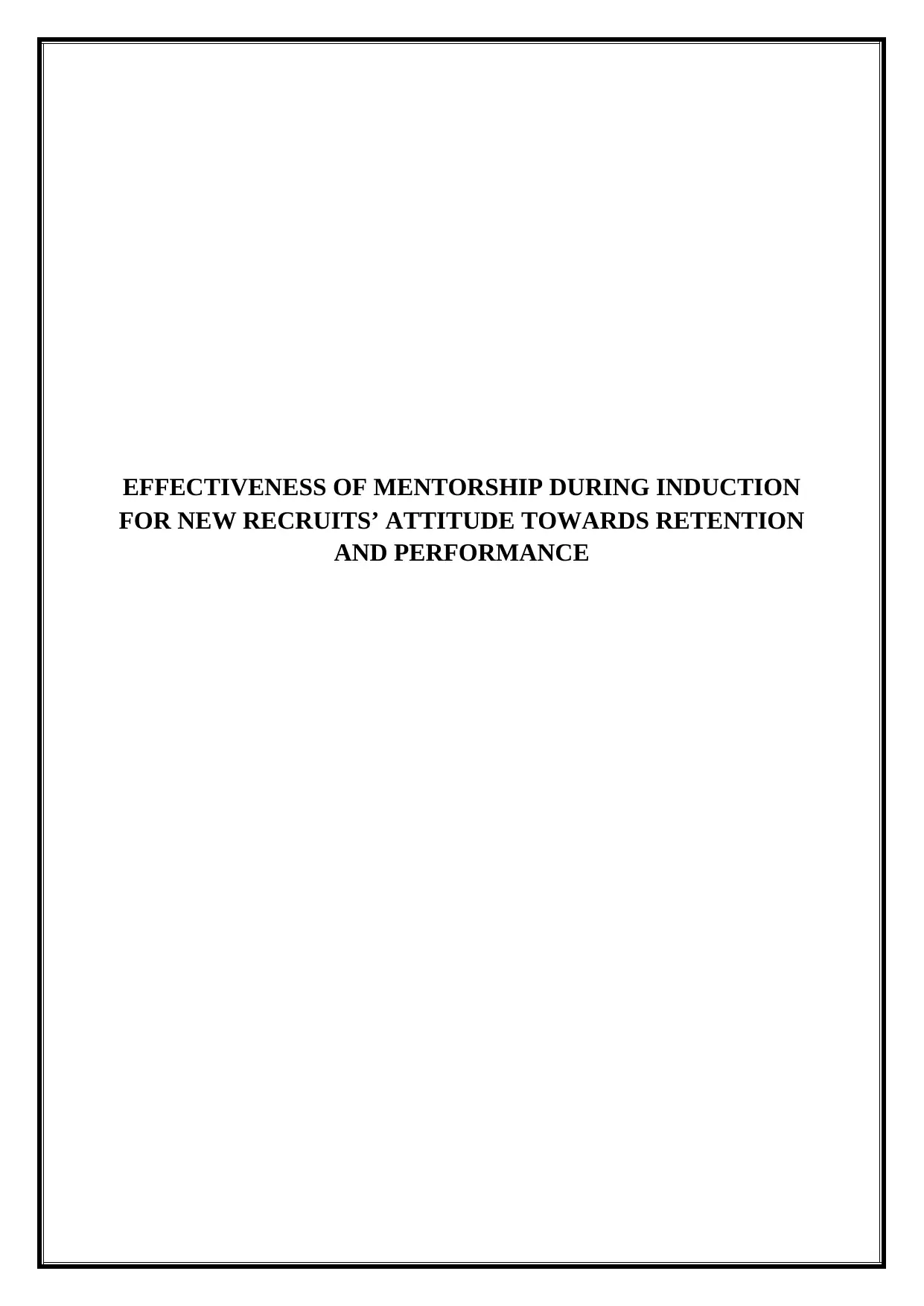
EFFECTIVENESS OF MENTORSHIP DURING INDUCTION
FOR NEW RECRUITS’ ATTITUDE TOWARDS RETENTION
AND PERFORMANCE
FOR NEW RECRUITS’ ATTITUDE TOWARDS RETENTION
AND PERFORMANCE
Paraphrase This Document
Need a fresh take? Get an instant paraphrase of this document with our AI Paraphraser
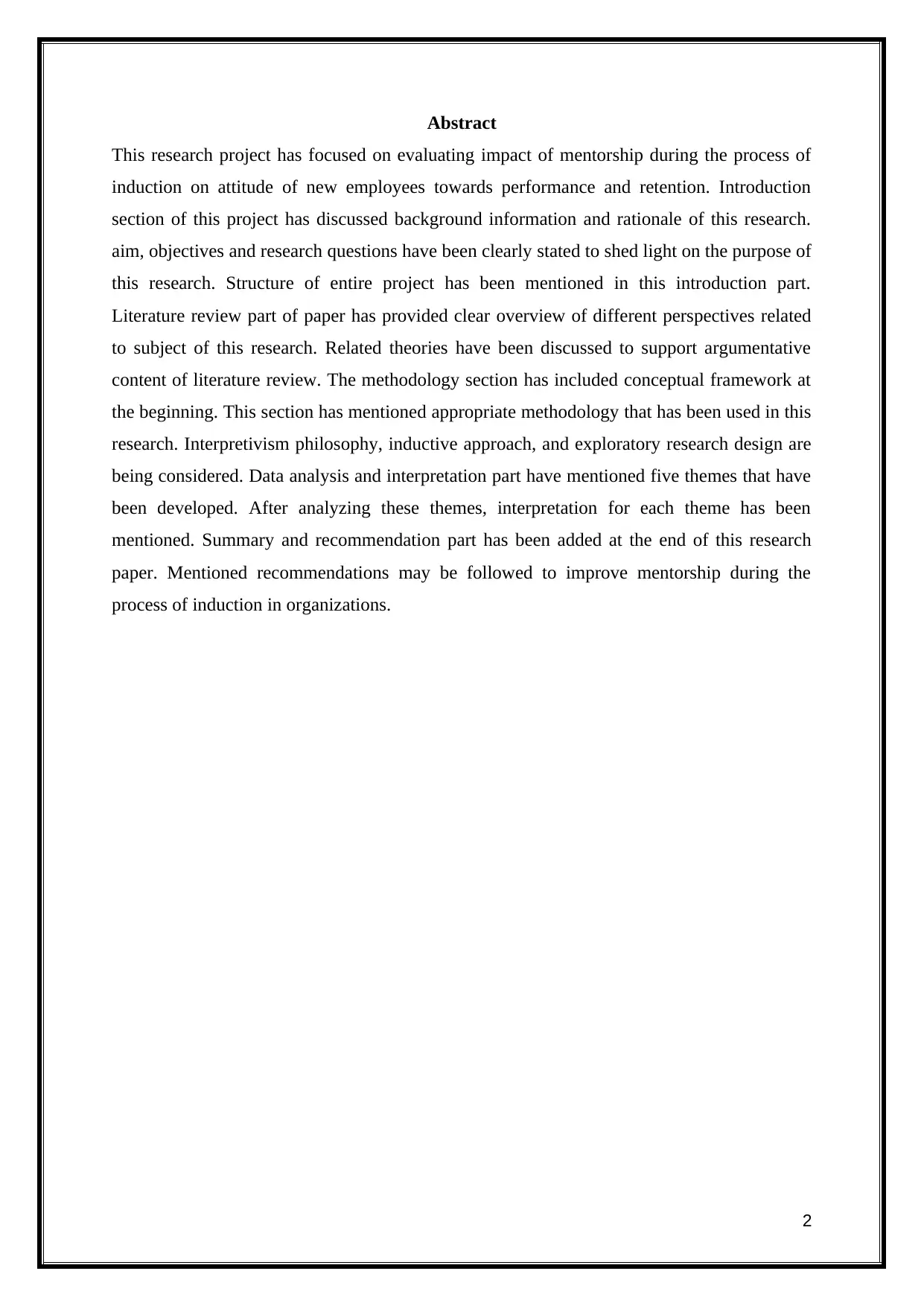
Abstract
This research project has focused on evaluating impact of mentorship during the process of
induction on attitude of new employees towards performance and retention. Introduction
section of this project has discussed background information and rationale of this research.
aim, objectives and research questions have been clearly stated to shed light on the purpose of
this research. Structure of entire project has been mentioned in this introduction part.
Literature review part of paper has provided clear overview of different perspectives related
to subject of this research. Related theories have been discussed to support argumentative
content of literature review. The methodology section has included conceptual framework at
the beginning. This section has mentioned appropriate methodology that has been used in this
research. Interpretivism philosophy, inductive approach, and exploratory research design are
being considered. Data analysis and interpretation part have mentioned five themes that have
been developed. After analyzing these themes, interpretation for each theme has been
mentioned. Summary and recommendation part has been added at the end of this research
paper. Mentioned recommendations may be followed to improve mentorship during the
process of induction in organizations.
2
This research project has focused on evaluating impact of mentorship during the process of
induction on attitude of new employees towards performance and retention. Introduction
section of this project has discussed background information and rationale of this research.
aim, objectives and research questions have been clearly stated to shed light on the purpose of
this research. Structure of entire project has been mentioned in this introduction part.
Literature review part of paper has provided clear overview of different perspectives related
to subject of this research. Related theories have been discussed to support argumentative
content of literature review. The methodology section has included conceptual framework at
the beginning. This section has mentioned appropriate methodology that has been used in this
research. Interpretivism philosophy, inductive approach, and exploratory research design are
being considered. Data analysis and interpretation part have mentioned five themes that have
been developed. After analyzing these themes, interpretation for each theme has been
mentioned. Summary and recommendation part has been added at the end of this research
paper. Mentioned recommendations may be followed to improve mentorship during the
process of induction in organizations.
2
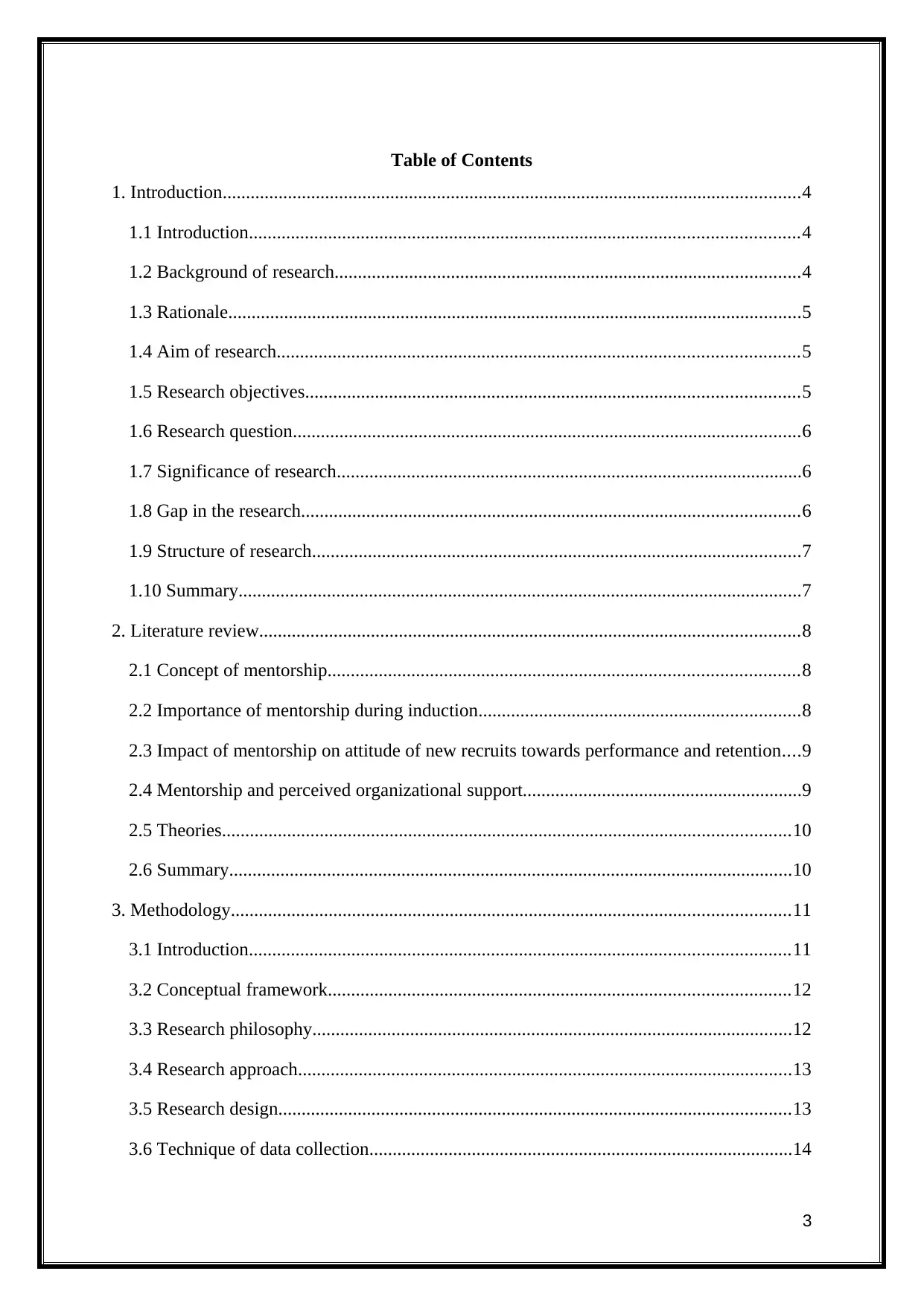
Table of Contents
1. Introduction............................................................................................................................4
1.1 Introduction......................................................................................................................4
1.2 Background of research....................................................................................................4
1.3 Rationale...........................................................................................................................5
1.4 Aim of research................................................................................................................5
1.5 Research objectives..........................................................................................................5
1.6 Research question.............................................................................................................6
1.7 Significance of research....................................................................................................6
1.8 Gap in the research...........................................................................................................6
1.9 Structure of research.........................................................................................................7
1.10 Summary.........................................................................................................................7
2. Literature review....................................................................................................................8
2.1 Concept of mentorship.....................................................................................................8
2.2 Importance of mentorship during induction.....................................................................8
2.3 Impact of mentorship on attitude of new recruits towards performance and retention....9
2.4 Mentorship and perceived organizational support............................................................9
2.5 Theories..........................................................................................................................10
2.6 Summary.........................................................................................................................10
3. Methodology........................................................................................................................11
3.1 Introduction....................................................................................................................11
3.2 Conceptual framework...................................................................................................12
3.3 Research philosophy.......................................................................................................12
3.4 Research approach..........................................................................................................13
3.5 Research design..............................................................................................................13
3.6 Technique of data collection...........................................................................................14
3
1. Introduction............................................................................................................................4
1.1 Introduction......................................................................................................................4
1.2 Background of research....................................................................................................4
1.3 Rationale...........................................................................................................................5
1.4 Aim of research................................................................................................................5
1.5 Research objectives..........................................................................................................5
1.6 Research question.............................................................................................................6
1.7 Significance of research....................................................................................................6
1.8 Gap in the research...........................................................................................................6
1.9 Structure of research.........................................................................................................7
1.10 Summary.........................................................................................................................7
2. Literature review....................................................................................................................8
2.1 Concept of mentorship.....................................................................................................8
2.2 Importance of mentorship during induction.....................................................................8
2.3 Impact of mentorship on attitude of new recruits towards performance and retention....9
2.4 Mentorship and perceived organizational support............................................................9
2.5 Theories..........................................................................................................................10
2.6 Summary.........................................................................................................................10
3. Methodology........................................................................................................................11
3.1 Introduction....................................................................................................................11
3.2 Conceptual framework...................................................................................................12
3.3 Research philosophy.......................................................................................................12
3.4 Research approach..........................................................................................................13
3.5 Research design..............................................................................................................13
3.6 Technique of data collection...........................................................................................14
3
⊘ This is a preview!⊘
Do you want full access?
Subscribe today to unlock all pages.

Trusted by 1+ million students worldwide
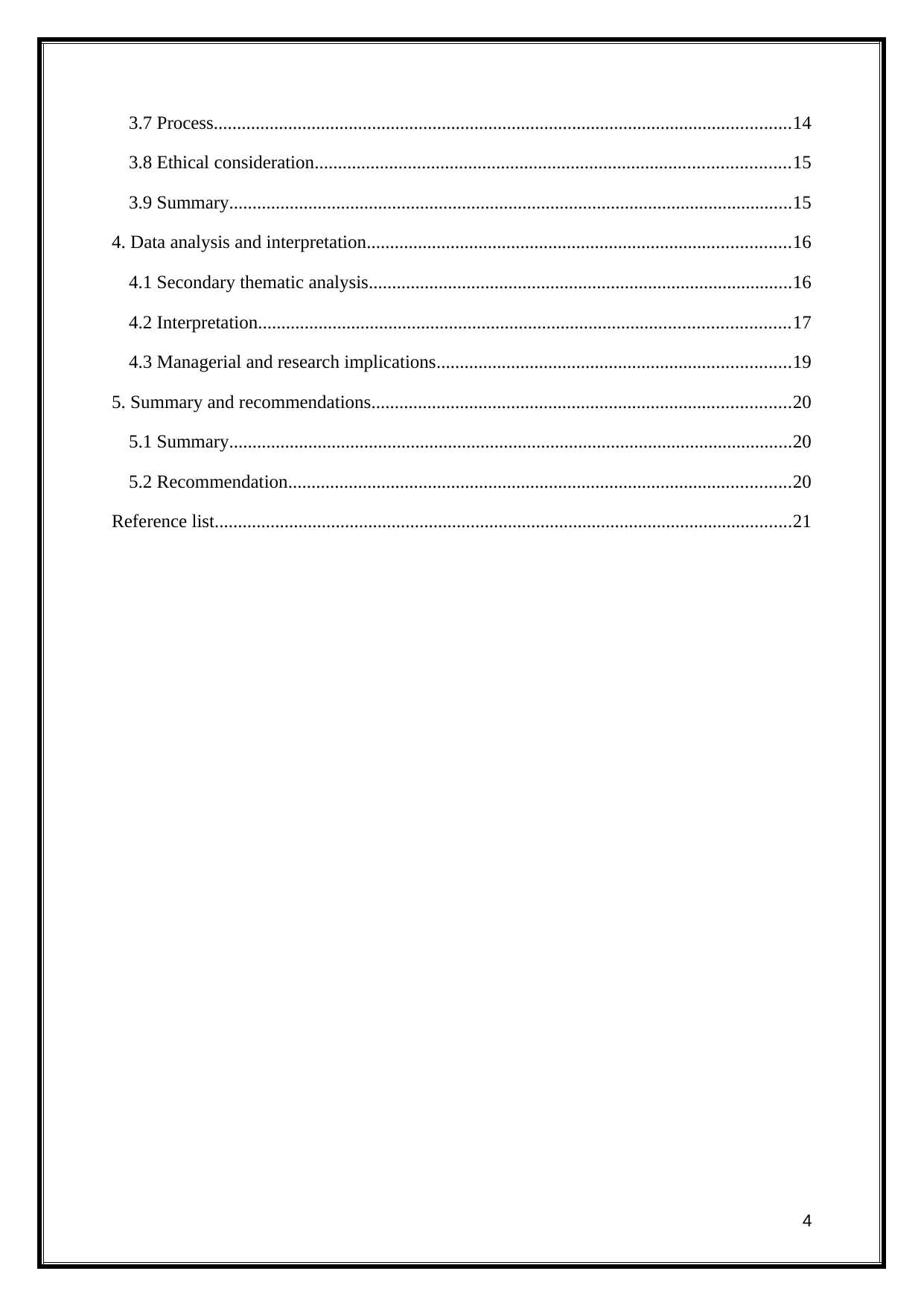
3.7 Process............................................................................................................................14
3.8 Ethical consideration......................................................................................................15
3.9 Summary.........................................................................................................................15
4. Data analysis and interpretation...........................................................................................16
4.1 Secondary thematic analysis...........................................................................................16
4.2 Interpretation..................................................................................................................17
4.3 Managerial and research implications............................................................................19
5. Summary and recommendations..........................................................................................20
5.1 Summary.........................................................................................................................20
5.2 Recommendation............................................................................................................20
Reference list............................................................................................................................21
4
3.8 Ethical consideration......................................................................................................15
3.9 Summary.........................................................................................................................15
4. Data analysis and interpretation...........................................................................................16
4.1 Secondary thematic analysis...........................................................................................16
4.2 Interpretation..................................................................................................................17
4.3 Managerial and research implications............................................................................19
5. Summary and recommendations..........................................................................................20
5.1 Summary.........................................................................................................................20
5.2 Recommendation............................................................................................................20
Reference list............................................................................................................................21
4
Paraphrase This Document
Need a fresh take? Get an instant paraphrase of this document with our AI Paraphraser
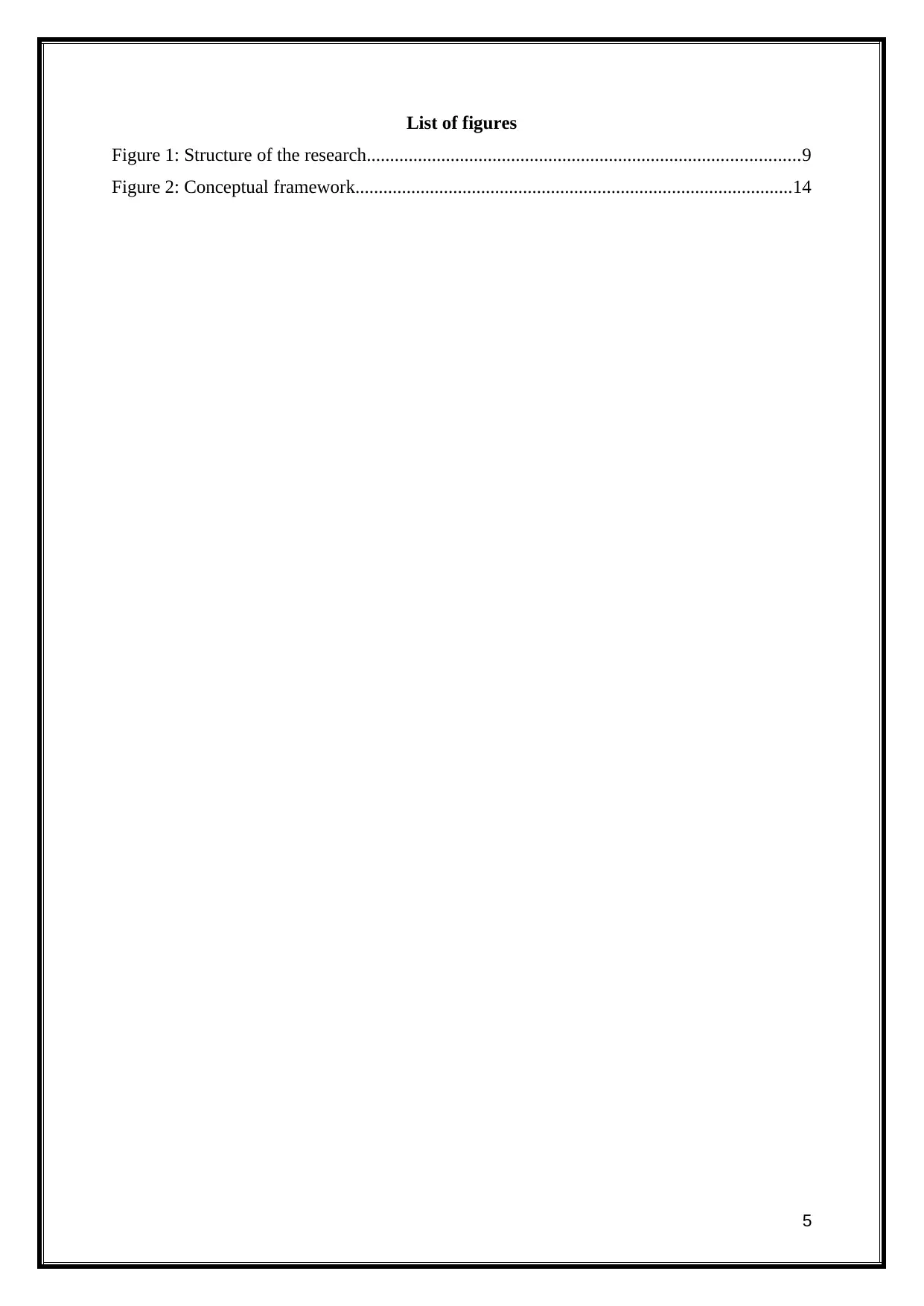
List of figures
Figure 1: Structure of the research.............................................................................................9
Figure 2: Conceptual framework..............................................................................................14
5
Figure 1: Structure of the research.............................................................................................9
Figure 2: Conceptual framework..............................................................................................14
5
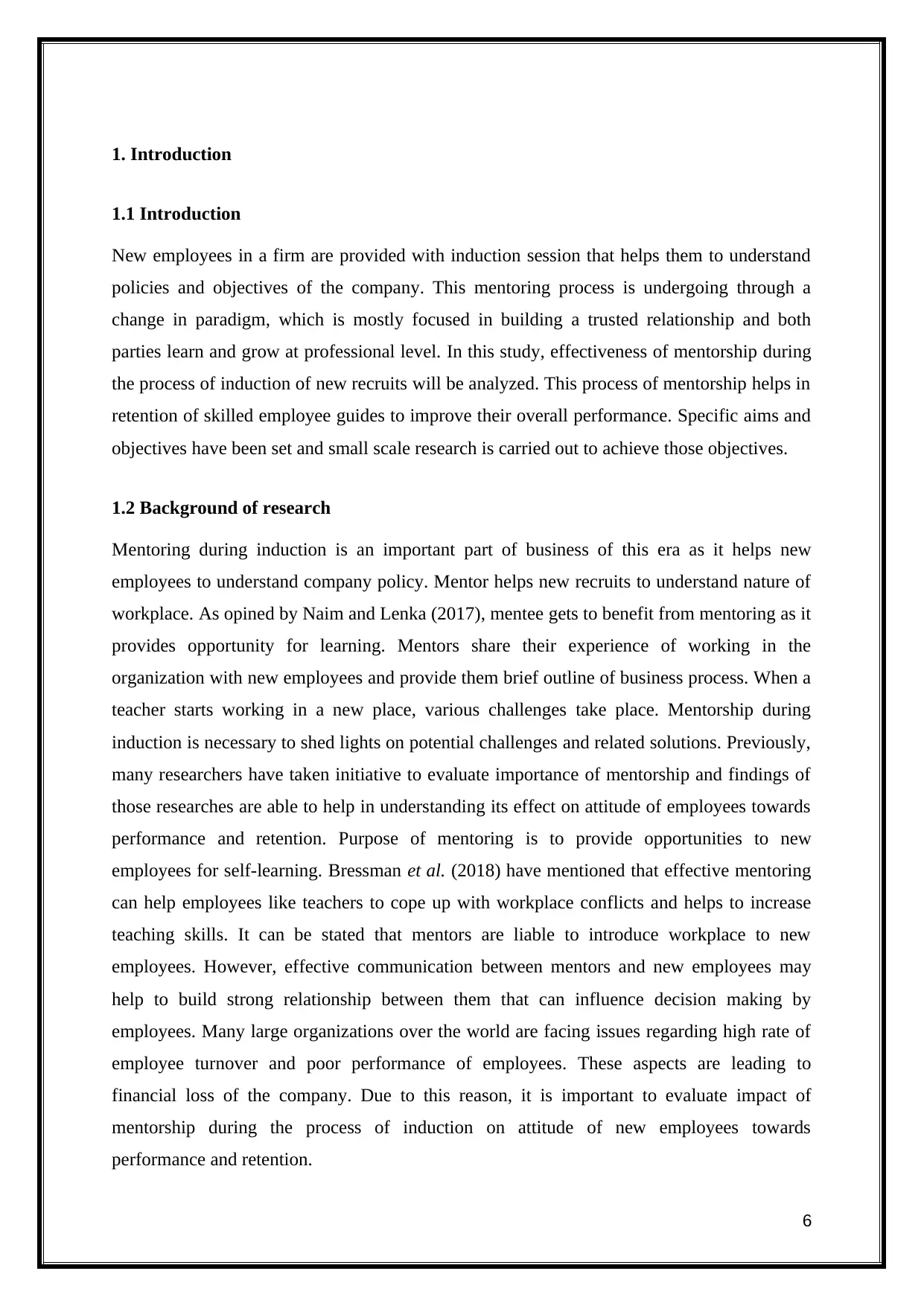
1. Introduction
1.1 Introduction
New employees in a firm are provided with induction session that helps them to understand
policies and objectives of the company. This mentoring process is undergoing through a
change in paradigm, which is mostly focused in building a trusted relationship and both
parties learn and grow at professional level. In this study, effectiveness of mentorship during
the process of induction of new recruits will be analyzed. This process of mentorship helps in
retention of skilled employee guides to improve their overall performance. Specific aims and
objectives have been set and small scale research is carried out to achieve those objectives.
1.2 Background of research
Mentoring during induction is an important part of business of this era as it helps new
employees to understand company policy. Mentor helps new recruits to understand nature of
workplace. As opined by Naim and Lenka (2017), mentee gets to benefit from mentoring as it
provides opportunity for learning. Mentors share their experience of working in the
organization with new employees and provide them brief outline of business process. When a
teacher starts working in a new place, various challenges take place. Mentorship during
induction is necessary to shed lights on potential challenges and related solutions. Previously,
many researchers have taken initiative to evaluate importance of mentorship and findings of
those researches are able to help in understanding its effect on attitude of employees towards
performance and retention. Purpose of mentoring is to provide opportunities to new
employees for self-learning. Bressman et al. (2018) have mentioned that effective mentoring
can help employees like teachers to cope up with workplace conflicts and helps to increase
teaching skills. It can be stated that mentors are liable to introduce workplace to new
employees. However, effective communication between mentors and new employees may
help to build strong relationship between them that can influence decision making by
employees. Many large organizations over the world are facing issues regarding high rate of
employee turnover and poor performance of employees. These aspects are leading to
financial loss of the company. Due to this reason, it is important to evaluate impact of
mentorship during the process of induction on attitude of new employees towards
performance and retention.
6
1.1 Introduction
New employees in a firm are provided with induction session that helps them to understand
policies and objectives of the company. This mentoring process is undergoing through a
change in paradigm, which is mostly focused in building a trusted relationship and both
parties learn and grow at professional level. In this study, effectiveness of mentorship during
the process of induction of new recruits will be analyzed. This process of mentorship helps in
retention of skilled employee guides to improve their overall performance. Specific aims and
objectives have been set and small scale research is carried out to achieve those objectives.
1.2 Background of research
Mentoring during induction is an important part of business of this era as it helps new
employees to understand company policy. Mentor helps new recruits to understand nature of
workplace. As opined by Naim and Lenka (2017), mentee gets to benefit from mentoring as it
provides opportunity for learning. Mentors share their experience of working in the
organization with new employees and provide them brief outline of business process. When a
teacher starts working in a new place, various challenges take place. Mentorship during
induction is necessary to shed lights on potential challenges and related solutions. Previously,
many researchers have taken initiative to evaluate importance of mentorship and findings of
those researches are able to help in understanding its effect on attitude of employees towards
performance and retention. Purpose of mentoring is to provide opportunities to new
employees for self-learning. Bressman et al. (2018) have mentioned that effective mentoring
can help employees like teachers to cope up with workplace conflicts and helps to increase
teaching skills. It can be stated that mentors are liable to introduce workplace to new
employees. However, effective communication between mentors and new employees may
help to build strong relationship between them that can influence decision making by
employees. Many large organizations over the world are facing issues regarding high rate of
employee turnover and poor performance of employees. These aspects are leading to
financial loss of the company. Due to this reason, it is important to evaluate impact of
mentorship during the process of induction on attitude of new employees towards
performance and retention.
6
⊘ This is a preview!⊘
Do you want full access?
Subscribe today to unlock all pages.

Trusted by 1+ million students worldwide
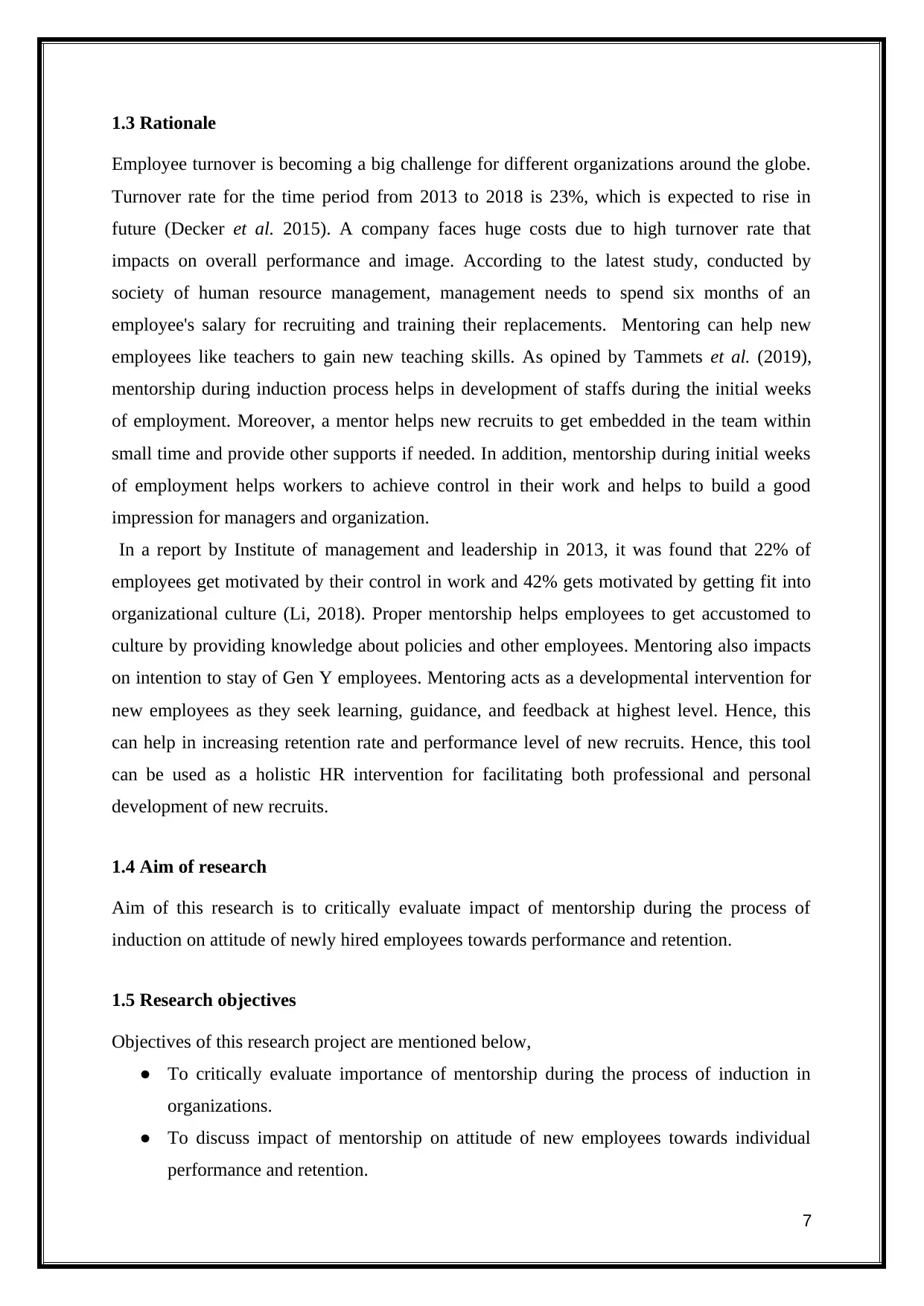
1.3 Rationale
Employee turnover is becoming a big challenge for different organizations around the globe.
Turnover rate for the time period from 2013 to 2018 is 23%, which is expected to rise in
future (Decker et al. 2015). A company faces huge costs due to high turnover rate that
impacts on overall performance and image. According to the latest study, conducted by
society of human resource management, management needs to spend six months of an
employee's salary for recruiting and training their replacements. Mentoring can help new
employees like teachers to gain new teaching skills. As opined by Tammets et al. (2019),
mentorship during induction process helps in development of staffs during the initial weeks
of employment. Moreover, a mentor helps new recruits to get embedded in the team within
small time and provide other supports if needed. In addition, mentorship during initial weeks
of employment helps workers to achieve control in their work and helps to build a good
impression for managers and organization.
In a report by Institute of management and leadership in 2013, it was found that 22% of
employees get motivated by their control in work and 42% gets motivated by getting fit into
organizational culture (Li, 2018). Proper mentorship helps employees to get accustomed to
culture by providing knowledge about policies and other employees. Mentoring also impacts
on intention to stay of Gen Y employees. Mentoring acts as a developmental intervention for
new employees as they seek learning, guidance, and feedback at highest level. Hence, this
can help in increasing retention rate and performance level of new recruits. Hence, this tool
can be used as a holistic HR intervention for facilitating both professional and personal
development of new recruits.
1.4 Aim of research
Aim of this research is to critically evaluate impact of mentorship during the process of
induction on attitude of newly hired employees towards performance and retention.
1.5 Research objectives
Objectives of this research project are mentioned below,
● To critically evaluate importance of mentorship during the process of induction in
organizations.
● To discuss impact of mentorship on attitude of new employees towards individual
performance and retention.
7
Employee turnover is becoming a big challenge for different organizations around the globe.
Turnover rate for the time period from 2013 to 2018 is 23%, which is expected to rise in
future (Decker et al. 2015). A company faces huge costs due to high turnover rate that
impacts on overall performance and image. According to the latest study, conducted by
society of human resource management, management needs to spend six months of an
employee's salary for recruiting and training their replacements. Mentoring can help new
employees like teachers to gain new teaching skills. As opined by Tammets et al. (2019),
mentorship during induction process helps in development of staffs during the initial weeks
of employment. Moreover, a mentor helps new recruits to get embedded in the team within
small time and provide other supports if needed. In addition, mentorship during initial weeks
of employment helps workers to achieve control in their work and helps to build a good
impression for managers and organization.
In a report by Institute of management and leadership in 2013, it was found that 22% of
employees get motivated by their control in work and 42% gets motivated by getting fit into
organizational culture (Li, 2018). Proper mentorship helps employees to get accustomed to
culture by providing knowledge about policies and other employees. Mentoring also impacts
on intention to stay of Gen Y employees. Mentoring acts as a developmental intervention for
new employees as they seek learning, guidance, and feedback at highest level. Hence, this
can help in increasing retention rate and performance level of new recruits. Hence, this tool
can be used as a holistic HR intervention for facilitating both professional and personal
development of new recruits.
1.4 Aim of research
Aim of this research is to critically evaluate impact of mentorship during the process of
induction on attitude of newly hired employees towards performance and retention.
1.5 Research objectives
Objectives of this research project are mentioned below,
● To critically evaluate importance of mentorship during the process of induction in
organizations.
● To discuss impact of mentorship on attitude of new employees towards individual
performance and retention.
7
Paraphrase This Document
Need a fresh take? Get an instant paraphrase of this document with our AI Paraphraser
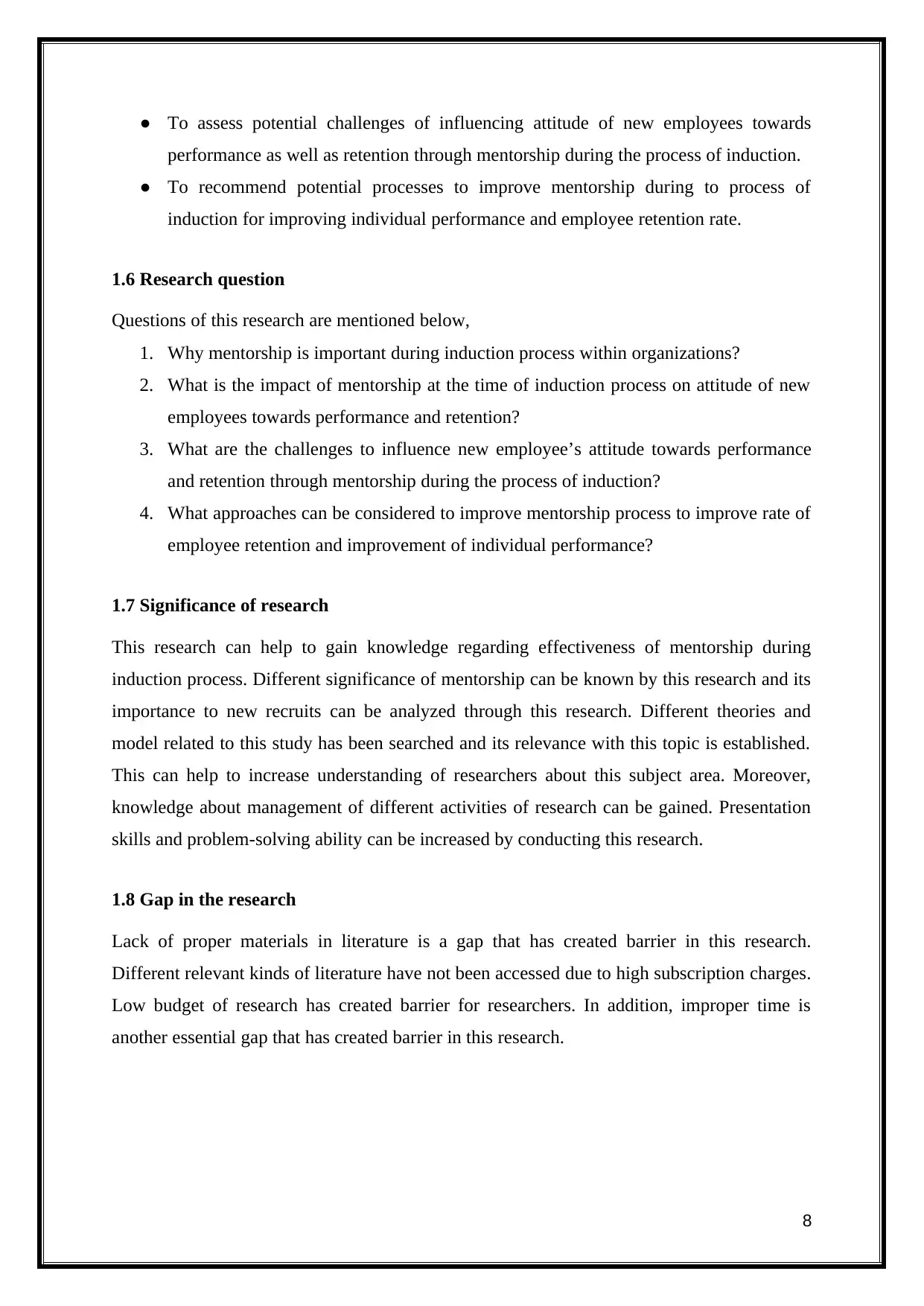
● To assess potential challenges of influencing attitude of new employees towards
performance as well as retention through mentorship during the process of induction.
● To recommend potential processes to improve mentorship during to process of
induction for improving individual performance and employee retention rate.
1.6 Research question
Questions of this research are mentioned below,
1. Why mentorship is important during induction process within organizations?
2. What is the impact of mentorship at the time of induction process on attitude of new
employees towards performance and retention?
3. What are the challenges to influence new employee’s attitude towards performance
and retention through mentorship during the process of induction?
4. What approaches can be considered to improve mentorship process to improve rate of
employee retention and improvement of individual performance?
1.7 Significance of research
This research can help to gain knowledge regarding effectiveness of mentorship during
induction process. Different significance of mentorship can be known by this research and its
importance to new recruits can be analyzed through this research. Different theories and
model related to this study has been searched and its relevance with this topic is established.
This can help to increase understanding of researchers about this subject area. Moreover,
knowledge about management of different activities of research can be gained. Presentation
skills and problem-solving ability can be increased by conducting this research.
1.8 Gap in the research
Lack of proper materials in literature is a gap that has created barrier in this research.
Different relevant kinds of literature have not been accessed due to high subscription charges.
Low budget of research has created barrier for researchers. In addition, improper time is
another essential gap that has created barrier in this research.
8
performance as well as retention through mentorship during the process of induction.
● To recommend potential processes to improve mentorship during to process of
induction for improving individual performance and employee retention rate.
1.6 Research question
Questions of this research are mentioned below,
1. Why mentorship is important during induction process within organizations?
2. What is the impact of mentorship at the time of induction process on attitude of new
employees towards performance and retention?
3. What are the challenges to influence new employee’s attitude towards performance
and retention through mentorship during the process of induction?
4. What approaches can be considered to improve mentorship process to improve rate of
employee retention and improvement of individual performance?
1.7 Significance of research
This research can help to gain knowledge regarding effectiveness of mentorship during
induction process. Different significance of mentorship can be known by this research and its
importance to new recruits can be analyzed through this research. Different theories and
model related to this study has been searched and its relevance with this topic is established.
This can help to increase understanding of researchers about this subject area. Moreover,
knowledge about management of different activities of research can be gained. Presentation
skills and problem-solving ability can be increased by conducting this research.
1.8 Gap in the research
Lack of proper materials in literature is a gap that has created barrier in this research.
Different relevant kinds of literature have not been accessed due to high subscription charges.
Low budget of research has created barrier for researchers. In addition, improper time is
another essential gap that has created barrier in this research.
8
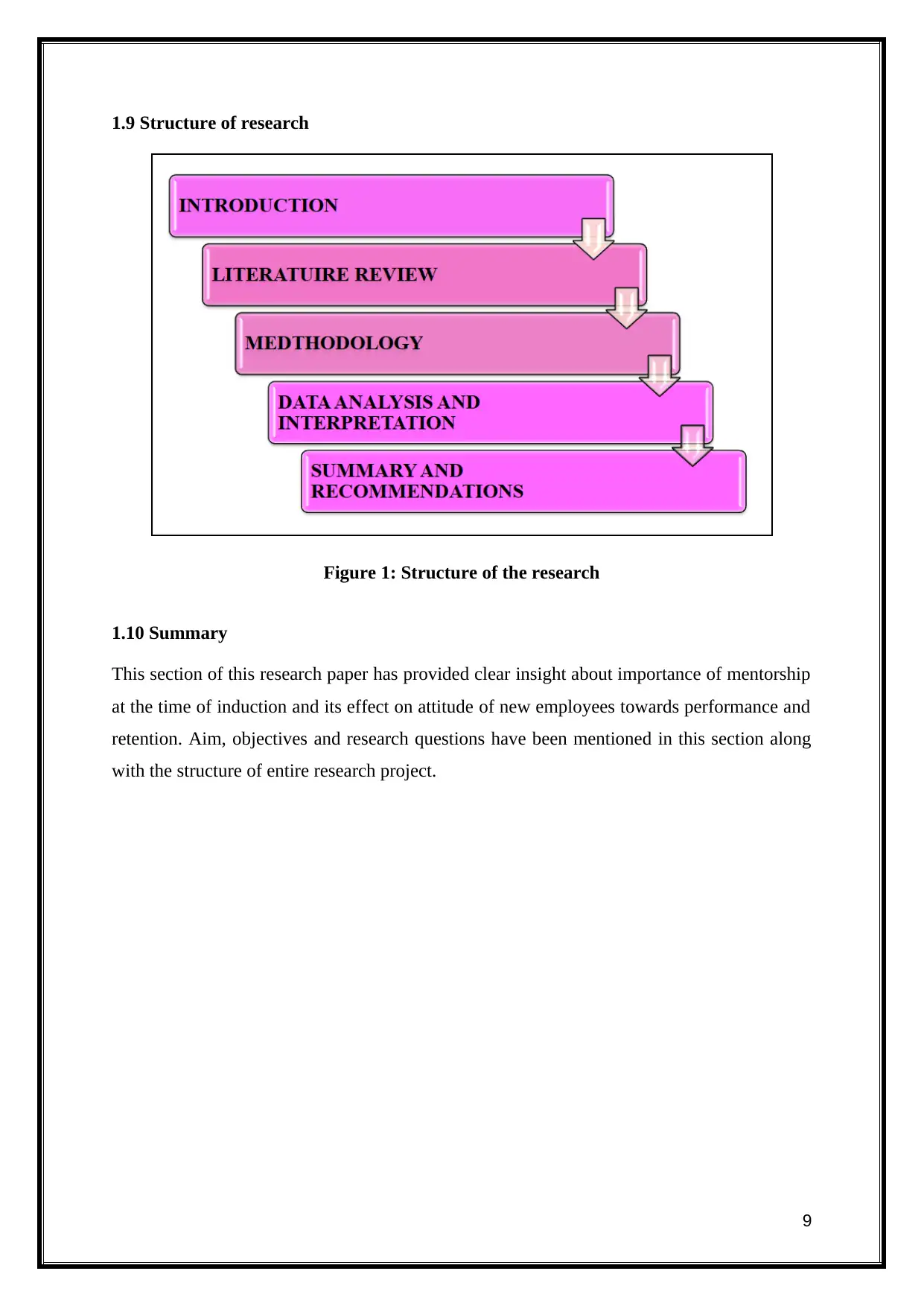
1.9 Structure of research
Figure 1: Structure of the research
1.10 Summary
This section of this research paper has provided clear insight about importance of mentorship
at the time of induction and its effect on attitude of new employees towards performance and
retention. Aim, objectives and research questions have been mentioned in this section along
with the structure of entire research project.
9
Figure 1: Structure of the research
1.10 Summary
This section of this research paper has provided clear insight about importance of mentorship
at the time of induction and its effect on attitude of new employees towards performance and
retention. Aim, objectives and research questions have been mentioned in this section along
with the structure of entire research project.
9
⊘ This is a preview!⊘
Do you want full access?
Subscribe today to unlock all pages.

Trusted by 1+ million students worldwide
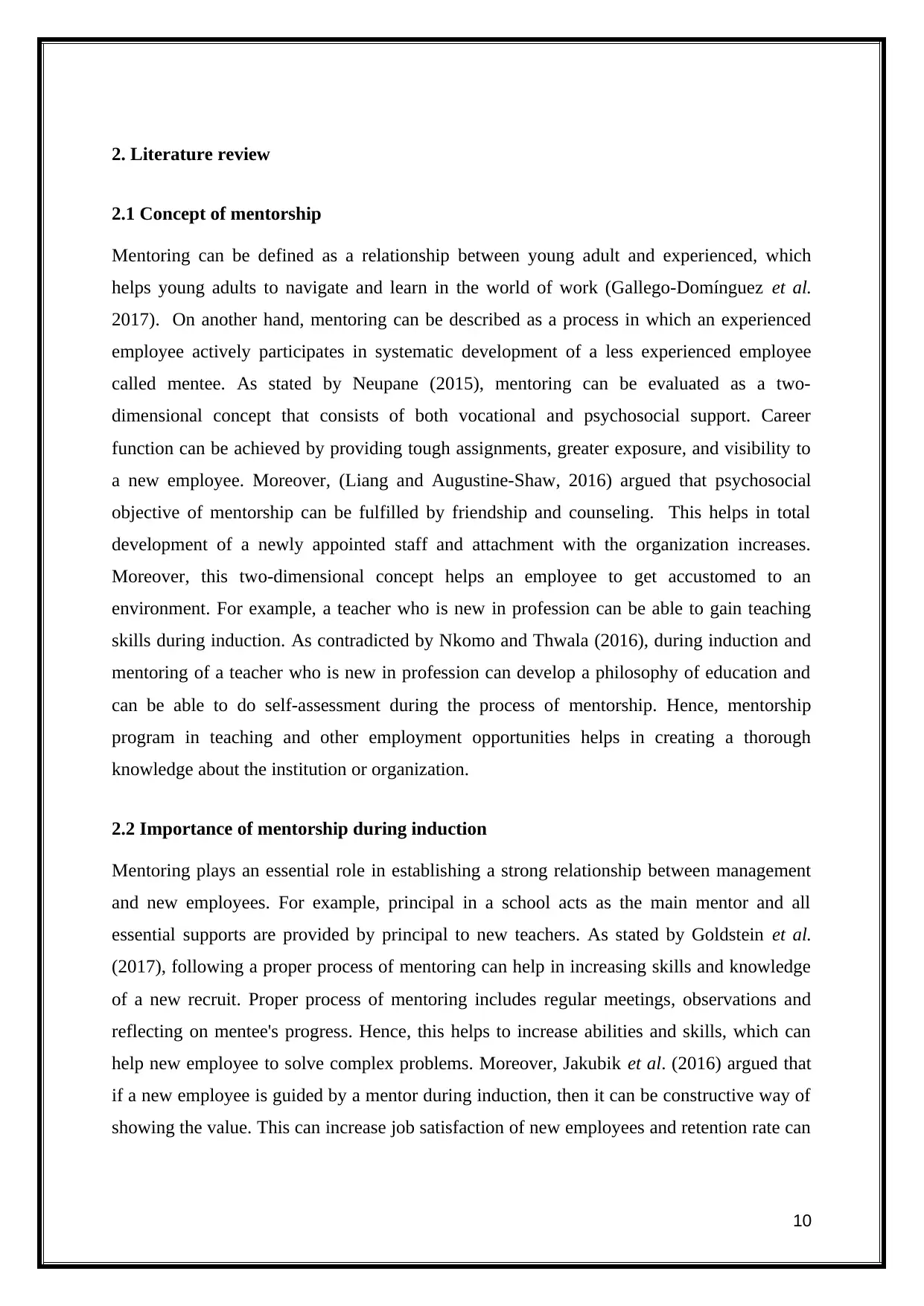
2. Literature review
2.1 Concept of mentorship
Mentoring can be defined as a relationship between young adult and experienced, which
helps young adults to navigate and learn in the world of work (Gallego-Domínguez et al.
2017). On another hand, mentoring can be described as a process in which an experienced
employee actively participates in systematic development of a less experienced employee
called mentee. As stated by Neupane (2015), mentoring can be evaluated as a two-
dimensional concept that consists of both vocational and psychosocial support. Career
function can be achieved by providing tough assignments, greater exposure, and visibility to
a new employee. Moreover, (Liang and Augustine-Shaw, 2016) argued that psychosocial
objective of mentorship can be fulfilled by friendship and counseling. This helps in total
development of a newly appointed staff and attachment with the organization increases.
Moreover, this two-dimensional concept helps an employee to get accustomed to an
environment. For example, a teacher who is new in profession can be able to gain teaching
skills during induction. As contradicted by Nkomo and Thwala (2016), during induction and
mentoring of a teacher who is new in profession can develop a philosophy of education and
can be able to do self-assessment during the process of mentorship. Hence, mentorship
program in teaching and other employment opportunities helps in creating a thorough
knowledge about the institution or organization.
2.2 Importance of mentorship during induction
Mentoring plays an essential role in establishing a strong relationship between management
and new employees. For example, principal in a school acts as the main mentor and all
essential supports are provided by principal to new teachers. As stated by Goldstein et al.
(2017), following a proper process of mentoring can help in increasing skills and knowledge
of a new recruit. Proper process of mentoring includes regular meetings, observations and
reflecting on mentee's progress. Hence, this helps to increase abilities and skills, which can
help new employee to solve complex problems. Moreover, Jakubik et al. (2016) argued that
if a new employee is guided by a mentor during induction, then it can be constructive way of
showing the value. This can increase job satisfaction of new employees and retention rate can
10
2.1 Concept of mentorship
Mentoring can be defined as a relationship between young adult and experienced, which
helps young adults to navigate and learn in the world of work (Gallego-Domínguez et al.
2017). On another hand, mentoring can be described as a process in which an experienced
employee actively participates in systematic development of a less experienced employee
called mentee. As stated by Neupane (2015), mentoring can be evaluated as a two-
dimensional concept that consists of both vocational and psychosocial support. Career
function can be achieved by providing tough assignments, greater exposure, and visibility to
a new employee. Moreover, (Liang and Augustine-Shaw, 2016) argued that psychosocial
objective of mentorship can be fulfilled by friendship and counseling. This helps in total
development of a newly appointed staff and attachment with the organization increases.
Moreover, this two-dimensional concept helps an employee to get accustomed to an
environment. For example, a teacher who is new in profession can be able to gain teaching
skills during induction. As contradicted by Nkomo and Thwala (2016), during induction and
mentoring of a teacher who is new in profession can develop a philosophy of education and
can be able to do self-assessment during the process of mentorship. Hence, mentorship
program in teaching and other employment opportunities helps in creating a thorough
knowledge about the institution or organization.
2.2 Importance of mentorship during induction
Mentoring plays an essential role in establishing a strong relationship between management
and new employees. For example, principal in a school acts as the main mentor and all
essential supports are provided by principal to new teachers. As stated by Goldstein et al.
(2017), following a proper process of mentoring can help in increasing skills and knowledge
of a new recruit. Proper process of mentoring includes regular meetings, observations and
reflecting on mentee's progress. Hence, this helps to increase abilities and skills, which can
help new employee to solve complex problems. Moreover, Jakubik et al. (2016) argued that
if a new employee is guided by a mentor during induction, then it can be constructive way of
showing the value. This can increase job satisfaction of new employees and retention rate can
10
Paraphrase This Document
Need a fresh take? Get an instant paraphrase of this document with our AI Paraphraser
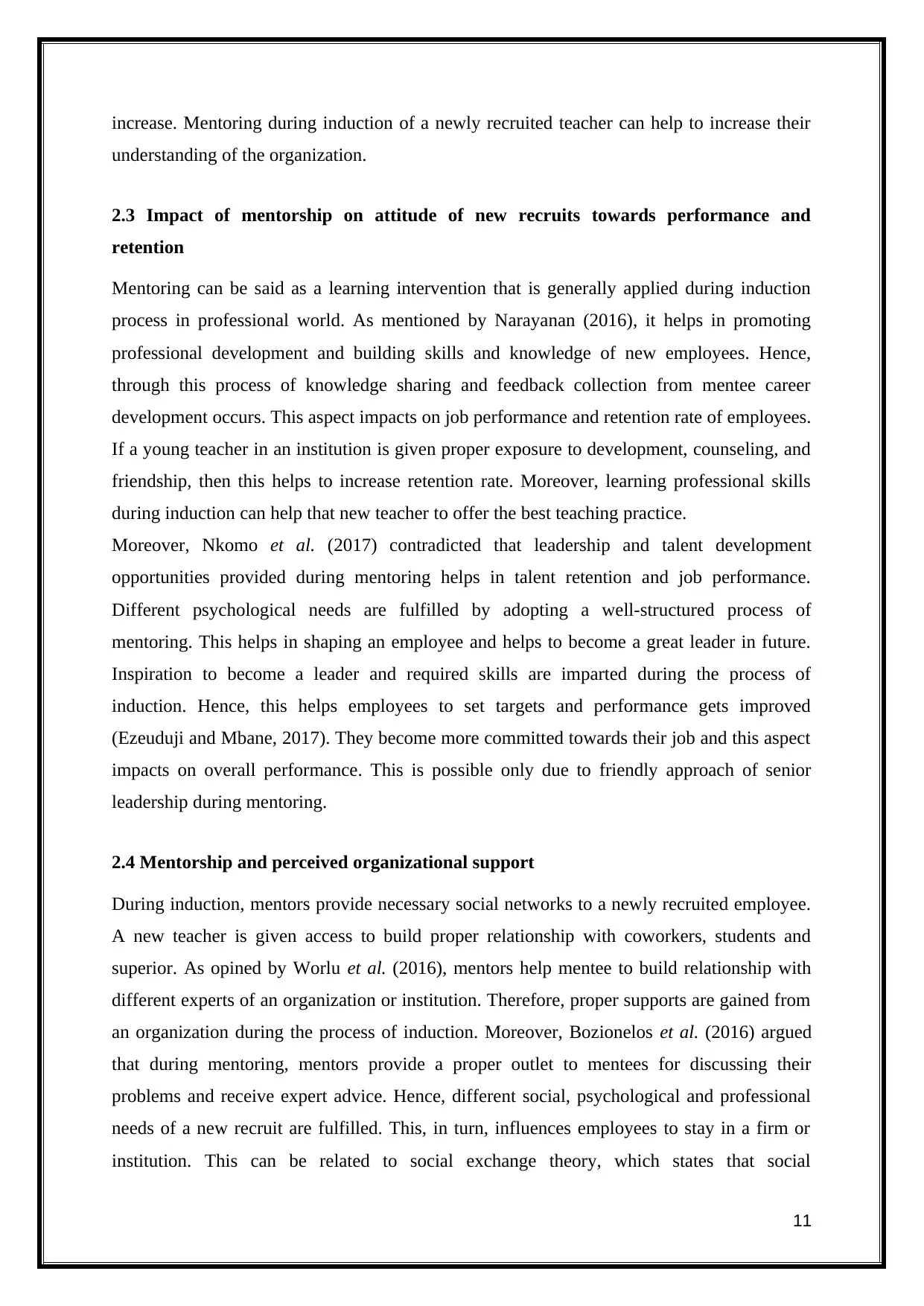
increase. Mentoring during induction of a newly recruited teacher can help to increase their
understanding of the organization.
2.3 Impact of mentorship on attitude of new recruits towards performance and
retention
Mentoring can be said as a learning intervention that is generally applied during induction
process in professional world. As mentioned by Narayanan (2016), it helps in promoting
professional development and building skills and knowledge of new employees. Hence,
through this process of knowledge sharing and feedback collection from mentee career
development occurs. This aspect impacts on job performance and retention rate of employees.
If a young teacher in an institution is given proper exposure to development, counseling, and
friendship, then this helps to increase retention rate. Moreover, learning professional skills
during induction can help that new teacher to offer the best teaching practice.
Moreover, Nkomo et al. (2017) contradicted that leadership and talent development
opportunities provided during mentoring helps in talent retention and job performance.
Different psychological needs are fulfilled by adopting a well-structured process of
mentoring. This helps in shaping an employee and helps to become a great leader in future.
Inspiration to become a leader and required skills are imparted during the process of
induction. Hence, this helps employees to set targets and performance gets improved
(Ezeuduji and Mbane, 2017). They become more committed towards their job and this aspect
impacts on overall performance. This is possible only due to friendly approach of senior
leadership during mentoring.
2.4 Mentorship and perceived organizational support
During induction, mentors provide necessary social networks to a newly recruited employee.
A new teacher is given access to build proper relationship with coworkers, students and
superior. As opined by Worlu et al. (2016), mentors help mentee to build relationship with
different experts of an organization or institution. Therefore, proper supports are gained from
an organization during the process of induction. Moreover, Bozionelos et al. (2016) argued
that during mentoring, mentors provide a proper outlet to mentees for discussing their
problems and receive expert advice. Hence, different social, psychological and professional
needs of a new recruit are fulfilled. This, in turn, influences employees to stay in a firm or
institution. This can be related to social exchange theory, which states that social
11
understanding of the organization.
2.3 Impact of mentorship on attitude of new recruits towards performance and
retention
Mentoring can be said as a learning intervention that is generally applied during induction
process in professional world. As mentioned by Narayanan (2016), it helps in promoting
professional development and building skills and knowledge of new employees. Hence,
through this process of knowledge sharing and feedback collection from mentee career
development occurs. This aspect impacts on job performance and retention rate of employees.
If a young teacher in an institution is given proper exposure to development, counseling, and
friendship, then this helps to increase retention rate. Moreover, learning professional skills
during induction can help that new teacher to offer the best teaching practice.
Moreover, Nkomo et al. (2017) contradicted that leadership and talent development
opportunities provided during mentoring helps in talent retention and job performance.
Different psychological needs are fulfilled by adopting a well-structured process of
mentoring. This helps in shaping an employee and helps to become a great leader in future.
Inspiration to become a leader and required skills are imparted during the process of
induction. Hence, this helps employees to set targets and performance gets improved
(Ezeuduji and Mbane, 2017). They become more committed towards their job and this aspect
impacts on overall performance. This is possible only due to friendly approach of senior
leadership during mentoring.
2.4 Mentorship and perceived organizational support
During induction, mentors provide necessary social networks to a newly recruited employee.
A new teacher is given access to build proper relationship with coworkers, students and
superior. As opined by Worlu et al. (2016), mentors help mentee to build relationship with
different experts of an organization or institution. Therefore, proper supports are gained from
an organization during the process of induction. Moreover, Bozionelos et al. (2016) argued
that during mentoring, mentors provide a proper outlet to mentees for discussing their
problems and receive expert advice. Hence, different social, psychological and professional
needs of a new recruit are fulfilled. This, in turn, influences employees to stay in a firm or
institution. This can be related to social exchange theory, which states that social
11
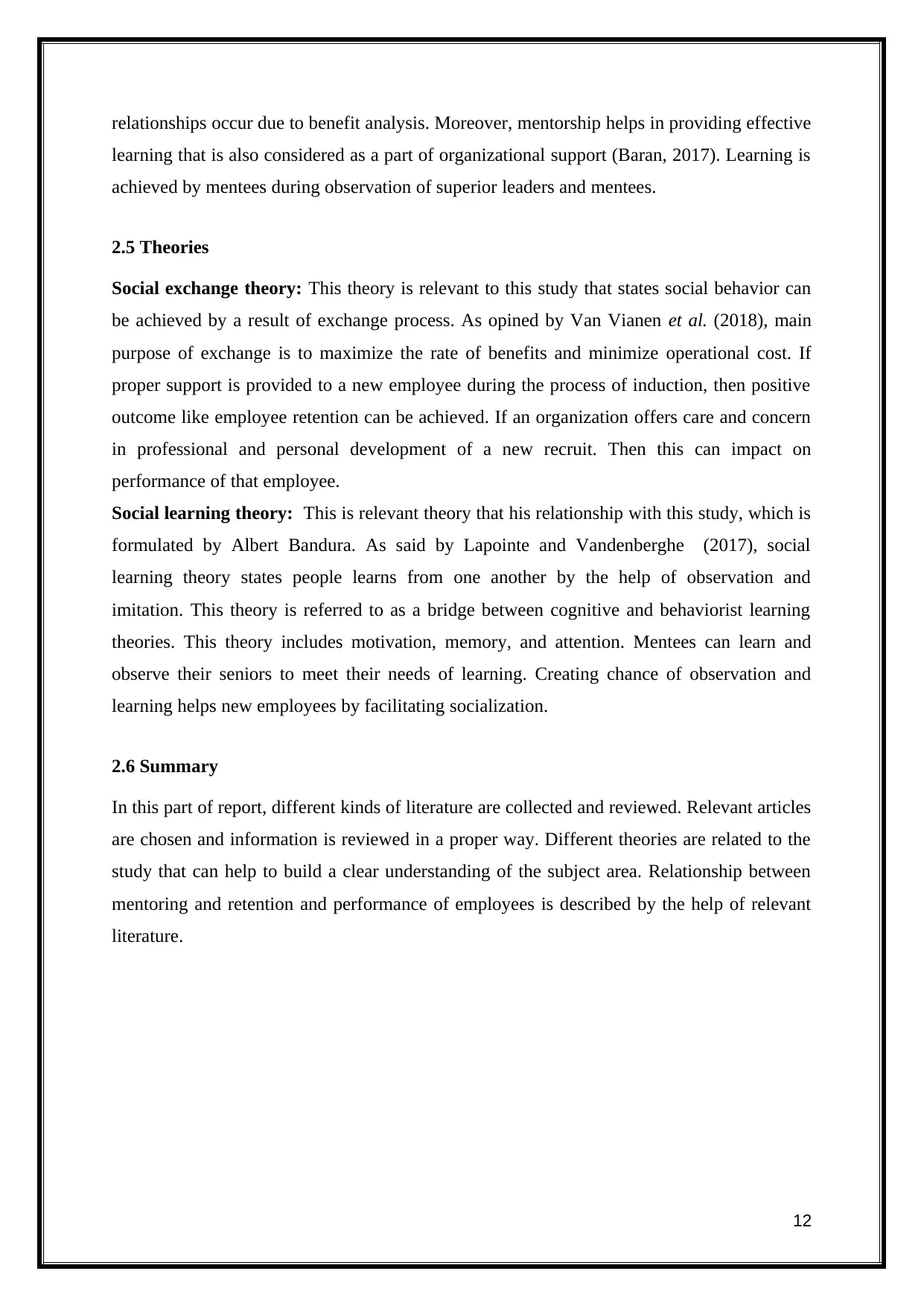
relationships occur due to benefit analysis. Moreover, mentorship helps in providing effective
learning that is also considered as a part of organizational support (Baran, 2017). Learning is
achieved by mentees during observation of superior leaders and mentees.
2.5 Theories
Social exchange theory: This theory is relevant to this study that states social behavior can
be achieved by a result of exchange process. As opined by Van Vianen et al. (2018), main
purpose of exchange is to maximize the rate of benefits and minimize operational cost. If
proper support is provided to a new employee during the process of induction, then positive
outcome like employee retention can be achieved. If an organization offers care and concern
in professional and personal development of a new recruit. Then this can impact on
performance of that employee.
Social learning theory: This is relevant theory that his relationship with this study, which is
formulated by Albert Bandura. As said by Lapointe and Vandenberghe (2017), social
learning theory states people learns from one another by the help of observation and
imitation. This theory is referred to as a bridge between cognitive and behaviorist learning
theories. This theory includes motivation, memory, and attention. Mentees can learn and
observe their seniors to meet their needs of learning. Creating chance of observation and
learning helps new employees by facilitating socialization.
2.6 Summary
In this part of report, different kinds of literature are collected and reviewed. Relevant articles
are chosen and information is reviewed in a proper way. Different theories are related to the
study that can help to build a clear understanding of the subject area. Relationship between
mentoring and retention and performance of employees is described by the help of relevant
literature.
12
learning that is also considered as a part of organizational support (Baran, 2017). Learning is
achieved by mentees during observation of superior leaders and mentees.
2.5 Theories
Social exchange theory: This theory is relevant to this study that states social behavior can
be achieved by a result of exchange process. As opined by Van Vianen et al. (2018), main
purpose of exchange is to maximize the rate of benefits and minimize operational cost. If
proper support is provided to a new employee during the process of induction, then positive
outcome like employee retention can be achieved. If an organization offers care and concern
in professional and personal development of a new recruit. Then this can impact on
performance of that employee.
Social learning theory: This is relevant theory that his relationship with this study, which is
formulated by Albert Bandura. As said by Lapointe and Vandenberghe (2017), social
learning theory states people learns from one another by the help of observation and
imitation. This theory is referred to as a bridge between cognitive and behaviorist learning
theories. This theory includes motivation, memory, and attention. Mentees can learn and
observe their seniors to meet their needs of learning. Creating chance of observation and
learning helps new employees by facilitating socialization.
2.6 Summary
In this part of report, different kinds of literature are collected and reviewed. Relevant articles
are chosen and information is reviewed in a proper way. Different theories are related to the
study that can help to build a clear understanding of the subject area. Relationship between
mentoring and retention and performance of employees is described by the help of relevant
literature.
12
⊘ This is a preview!⊘
Do you want full access?
Subscribe today to unlock all pages.

Trusted by 1+ million students worldwide
1 out of 25
Related Documents
Your All-in-One AI-Powered Toolkit for Academic Success.
+13062052269
info@desklib.com
Available 24*7 on WhatsApp / Email
![[object Object]](/_next/static/media/star-bottom.7253800d.svg)
Unlock your academic potential
Copyright © 2020–2025 A2Z Services. All Rights Reserved. Developed and managed by ZUCOL.





